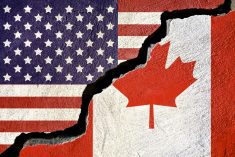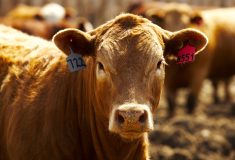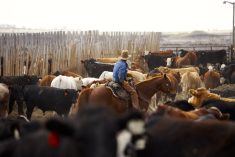I’ve received many calls from cattle producers over the past few months regarding the feed and forage markets. The drought resulted in lower western Canadian grain and oilseed production. Forage crops were also devastated in many regions. Cow-calf producers are struggling with historical high forage and hay prices. Feedlot operators are facing the highest feed grain prices in history.
Some producers have managed fairly well through this period and are in decent shape over the winter. They purchased weather and market analysis earlier in the spring and took the appropriate action to endure this difficult period. Needless to say, there are always those producers who don’t take any precautions to upcoming risks. They say market analysis is too expensive for them. The most common response I receive is that “I’m a small operator so I can’t afford it.”
Read Also

Canadian Beef Check-Off Agency reports on investments and activities
The check-off agency’s work behind the scenes is what ensures cattle check-off dollars are invested wisely, accounted for transparently and deliver measurable value back to producers and importers.
The smaller your operation, the more you need to learn and the more you need to spend on market analysis. A smaller operation doesn’t have the economies of scale. Cattle production is a purely competitive market. In a purely competitive market, margins are zero per head long-term. Costs drop to the least-cost producer. This is Economics 101. Ask yourself, what are my edge and competitive advantage? If you can’t asnwer this immediately, you don’t have an edge. You have to be smarter than others.
Let’s look at this last year as an example. Western Canadian weather patterns move in 18-year cycles. The early 2000s were very dry years in Alberta and Saskatchewan. The years 2002 and 2003 were particularly dry. Many friends of mine from university didn’t start their combines in these years. Just knowing this information tells you that you have to be prepared for a drought in 2020 and 2021. Cow-calf producers need to be aware of this and plan in advance accordingly. In any case, there are a lot of weather services available for as little as $200 per year. If you are a cattle producer or engaged in any type of farming, you need to subscribe to a weather service. It will pay off immensely. Trust me, it will keep you in business. If you are sleeping on a railway track and see a train coming, you need to get off the track. The 2021 drought was a freight train long time coming and yet many producers were surprised. You should have started to plan for the 2021 drought back in 2003.
Second, fundamental market information is vital to your long-term strategy and long-term success. Statistics Canada estimated the barley crop at 7.1 million tonnes, down from the 2020 output of 10.7 million tonnes. Some analysts like myself believe the 2021 crop is even smaller. Canfax reported that cattle-on-feed inventories in Alberta and Saskatchewan are up nearly 20 per cent from last year. The Canadian Grain Commission reports weekly barley exports every Thursday. For the week ending October 31, Canadian barley exports were 962,000 tonnes compared to 907,000 tonnes last year. Production is down 35 per cent, domestic feed demand is up 20 per cent and export demand is up about 10 per cent. Should the price go up or down? This information is all at your fingertips. However, markets are efficient. Getting this information is helpful in a long-term trend. Receiving forecasts from analysts in advance gives you even more of an edge.
In some cases, you have to treat your cow-calf operation as a factory. When the central banks drop their benchmark rate to historical lows and have an easy money policy, you have to expand your factory. The central banks do this for your benefit and also for the economic well-being of the country. Put aside the sarcasm or the conspiracy theories for a minute. If you don’t grow a bit each year, your operation shrinks because of inflation. This is sure. A factory will know how demand changes with changes in interest rates. Despite the COVID-19 lockdowns last year, beef demand went up. North American consumers ate more beef at higher prices.
Technology and genetics improve production practices to enhance efficiencies. Twenty years ago, a 600-pound calf was a big calf; now an 800-pound steer is a big calf. Producers are on top of the most modern production practices. Somehow when it comes to market intelligence, this has slipped by the wayside.
A famous quote by Warren Buffet goes like this: “Read 500 pages every day. That’s how knowledge works. It builds up like compound interest. All of you can do it, but I guarantee not many of you will do it.”
We can’t be envious of successful people; we have to emulate them. We have to learn from them. I stated to one caller, if you are not going to invest $2,000 per year on market information and making yourself more intelligent, then you have other issues. You can get help with this. My main point is this: invest in yourself and don’t be cheap. There is plenty of market information available; some of it you have to pay for. Instead of buying a new pickup truck, invest in yourself. We can and are obligated to help our neighbours when there are adverse natural disasters; this is Christian-like. We can also help our neighbours make better decisions and save for the drought instead of the rainy day. We can tell them when the freight train is expected.
















